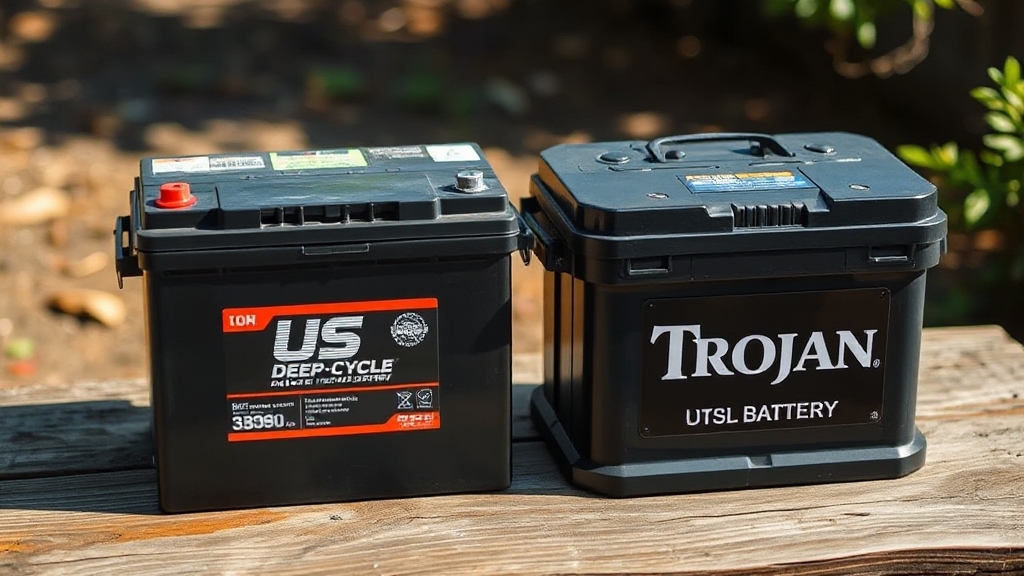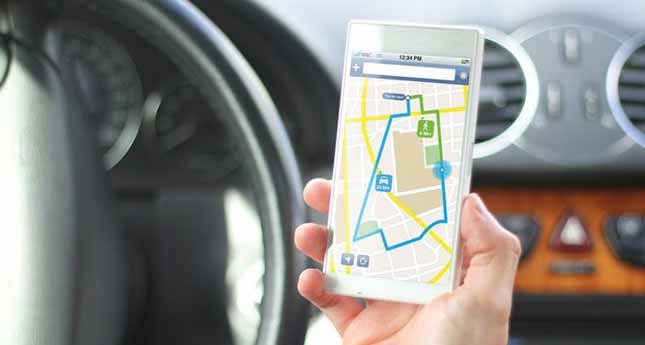Last Updated on June 1, 2025
If you need a deep-cycle battery, US Battery offers robust flooded and AGM options with higher reserve capacity and slightly lower prices, making them cost-effective for budget-conscious users.
Trojan Battery, with nearly a century of innovation, provides advanced features like superior plate uniformity and maintenance-free AGM models, delivering longer lifespan and consistent performance.
Both brands have solid customer support, but Trojan emphasizes sustainability and brand reliability. Understanding their differences can help you choose the best fit for your power needs.
- BCI Group: GC12
- Voltage: 12
- Type: Flooded Lead Acid
- T-875 Deep-Cycle Flooded/Wet Lead-Acid Battery.
Key Takeaways
- Trojan batteries are known for advanced technology, longer lifespan, and higher capacity, often lasting 5–7 years with superior maintenance features.
- US Battery offers more affordable options with higher reserve capacity and heavier construction, appealing to cost-conscious buyers needing robust performance.
- Trojan holds a dominant market share with strong brand trust, sustainability efforts, and extensive innovation in AGM and lithium battery technologies.
- US Battery provides better cost-per-amp-hour value, making it attractive for budget-sensitive applications.
- Both brands provide strong customer support, but Trojan typically offers longer-term protection and more extensive coverage for original buyers.
History and Industry Background
Although Trojan Battery began nearly a century ago in 1925 as an automotive battery repair business in the Los Angeles area, it quickly shifted focus to manufacturing deep-cycle batteries for commercial and recreational use.
Starting in 1925, Trojan Battery transitioned from repairs to pioneering deep-cycle batteries for diverse uses. You’ll find that Trojan pioneered deep-cycle golf car batteries in the 1950s and expanded operations by relocating to Santa Fe Springs in the 1960s and 1970s.
Their market focus evolved from automotive to golf carts, marine, and industrial equipment, reflecting a strategic response to industry demands. This shift required reliable power sources, similar to how Class C motorhomes depend on high-quality batteries for optimal performance.
Technologically, Trojan advanced battery performance with innovations like the Maxguard Advanced Design Separator in the 1980s. They also broadened manufacturing by establishing a facility in Lithonia, Georgia, and opened the Trojan Technology Center in 1992 to emphasize research and development.
Family leadership continued to drive growth with Dick and Ray Godber expanding the company during the mid-20th century. These strategic moves positioned Trojan as a leader in deep-cycle battery technology.
Battery Types and Model Options
When selecting between US Battery and Trojan Battery, you’ll find each brand offers distinct battery types tailored to various applications.
Trojan provides deep-cycle flooded, AGM, and advanced lithium batteries, known for long-range, maintenance-free use with fast charging. Notably, Trojan Lithium batteries deliver the longest range, emphasizing their suitability for demanding use cases.
US Battery focuses on robust flooded and AGM models, emphasizing reliability across golf carts, electric vehicles, and industrial settings. US Battery offers varied capacities in standard BCI sizes, favoring compact designs for space-limited installations.
Both brands accommodate motive and stationary power needs, but Trojan leans toward renewable energy and RV systems, whereas US Battery suits backup power and heavy-duty applications.
Performance Attributes and Features
Since performance attributes directly impact battery efficiency and lifespan, understanding the technical distinctions between US Battery and Trojan Battery is essential. US Battery features a higher reserve capacity (965 minutes vs. Trojan’s 850) and employs a 5% Antinium alloy blend, reducing corrosion more effectively than Trojan’s 4% antimony.
Its Diamond Plate Xtreme Capacity2 technology and 15 plates per cell enhance capacity and durability, while synthetic tetrabasic lead sulfate guarantees uniform crystal size for better performance. These advanced materials contribute to the battery’s ability to withstand harsh conditions.
US Battery’s advanced alloy and plate technology boost capacity, durability, and corrosion resistance beyond Trojan’s performance. You’ll also find US Battery meets California Energy Commission standards for charging efficiency, offering faster cycles to full capacity and improved voltage stability.
Although slightly heavier, it requires less maintenance due to a larger water level margin and superior plate durability. These features collectively deliver longer life and higher energy output compared to Trojan. The heavy weight of these batteries suggests a robust build quality, suitable for demanding use and long-term longevity.
Pricing Comparison and Value Analysis
When comparing US Battery and Trojan Battery, you’ll notice US Battery models generally come at a lower upfront cost, offering competitive pricing per amp-hour. Consider that lead-acid batteries like these typically require regular maintenance to achieve their maximum lifespan.
However, evaluating long-term value requires factoring in durability, maintenance needs. Trojan batteries, including popular models like the T-105 and L16P-AC, provide a wide range of high-capacity options that cater to various performance requirements.
Balancing initial expenses with lifespan and reliability will help you determine which brand aligns better with your budget and performance expectations.
Long-Term Value
While upfront costs often guide your initial purchase decision, evaluating long-term value requires analyzing durability, performance, and total cost of ownership.
Trojan batteries typically offer 5-7 years of service with 1,200 cycles, outperforming many competitors in longevity and cycle life. Their thicker plates (0.080”) and proprietary lead-calcium alloy reduce water loss and maintenance, enhancing durability and reliability, especially under heavy use.
Trojan’s robotic manufacturing process ensures plate uniformity within 0.002 tolerance, preventing hot spots and further improving battery longevity. Trojan’s deep-cycle design delivers 15-25% more usable energy per cycle, lowering replacement frequency and overall system costs.
Additionally, their higher amp-hour capacity and superior discharge tolerance improve energy efficiency and recovery after deep discharges. This makes them particularly suitable for deep cycle applications such as enclosed trailers.
Considering consistent performance, reduced maintenance, and extended lifespan, Trojan batteries present a more cost-effective solution over time compared to US Battery options, particularly for applications demanding reliability and sustained energy output.
Market Presence and Brand Reputation
When evaluating deep-cycle batteries, you’ll notice that Trojan Battery Company commands significant market presence and brand recognition built over nearly a century.
Established in 1925, Trojan holds a dominant 63% share in deep-cycle batteries, especially for golf carts, supported by extensive international offices and major retail partnerships like Sam’s Club.
Trojan batteries at Sam’s Club offer deep-cycle capabilities, suitable for frequent use, making them a preferred choice among commercial users for reliable performance. Their products often feature maintenance-free AGM technology, enhancing convenience for end users.
You’ll find Trojan’s widespread distribution network enhances product accessibility and aftermarket support. In contrast, US Battery serves niche markets with a smaller footprint and less global reach.
Regarding brand reputation, Trojan consistently earns praise for reliability, innovation, and long service life, validated by the 2024 BCI Amplify Award.
While US Battery is respected for durability, Trojan’s nearly 100 years of leadership and broad product range position it as the industry benchmark you’ll likely trust for premium deep-cycle battery needs. Trojan models deliver robust, reliable performance for golf carts, emphasizing sustained energy output over just cold-cranking amps.
Environmental Impact and Sustainability Efforts
Although environmental impact is a critical factor in battery manufacturing, Trojan Battery demonstrates measurable progress in sustainability through targeted emissions reductions, water conservation, and enhanced recycling programs.
Since 2020, Trojan has reduced CO2e emissions per battery unit by 51% in North America, achieving a 2.1% reduction in 2024 alone. The company aims to cut energy use in U.S. factories by 25% over the next decade, participating in the DOE’s Better Plants program. Trojan also sets annual targets for emission reductions and energy conservation to ensure continuous improvement. These efforts contribute to reducing harmful emissions associated with manufacturing processes.
Water consumption per unit dropped 6.1% in 2024, aligning with UN Sustainable Development Goals. Trojan’s lead-acid batteries are 99% recyclable, incorporating 80% reclaimed materials, minimizing waste.
Supporting electric vehicle markets further reduces greenhouse gases and noise pollution. These efforts reflect Trojan’s commitment to measurable, data-driven sustainability within a global framework.
Frequently Asked Questions
Which Battery Brand Is Easier to Recycle Locally?
You’ll find that batteries with established recycling programs and local partnerships are easier to recycle. If a brand offers nationwide collection points, customer support for recycling, and works with authorized recyclers, you can recycle locally with less hassle.
Without clear local recycling info, you might struggle to find convenient options. Look for brands that provide drop-off locations, pickup services, and certifications to guarantee responsible handling and compliance with environmental regulations.
Are There Specific Tools Needed for Maintenance on Either Brand?
For maintenance, you’ll need basic tools like a hydrometer, voltmeter, and wrench to check fluid levels and connections. Both brands recommend distilled water to prevent mineral buildup.
Trojan specifically advises using smart chargers and petroleum jelly to protect posts, while US Battery focuses on standard chargers. Safety gear like gloves and goggles is essential for both.
How Do Charging Times Compare Between Their Lithium Batteries?
You’ll find that lithium batteries generally charge much faster than lead-acid types, often in under two hours. Trojan lithium batteries typically take up to 2.5 hours to fully charge, which is still efficient.
Although U.S. Battery hasn’t specified exact times, their lithium options likely charge faster than Trojan’s, benefiting from advanced charging efficiency. In both cases, faster charging doesn’t reduce battery lifespan, maintaining long-term reliability.
What Common Troubleshooting Issues Do Users Face With Each Brand?
Isn’t it just delightful when your battery leaks or corrodes unexpectedly? You’ll encounter leakage and corrosion issues, especially if you skip regular maintenance, which reduces performance over time. Charging errors and temperature sensitivity can also damage cells.
On the other hand, you’ll wrestle with electrolyte stratification and precise specific gravity control, demanding frequent equalization. Both require diligent upkeep, neglecting it only accelerates aging and performance loss. Stay vigilant to avoid these pitfalls.
Can These Batteries Be Used Interchangeably in the Same Vehicle?
You can use batteries interchangeably in the same vehicle if they match in voltage, size, and terminal configuration. However, you should verify the charge profile and amp-hour rating to guarantee compatibility with your charger and system requirements.
Differences in charge settings may require adjustments to avoid undercharging or damage. Always confirm dimensions and maintenance needs, as mismatched specifications can affect performance and longevity.
Choosing Your Power Partner: US Battery vs Trojan
When choosing between US Battery and Trojan Battery, picture a power source tailored to your needs, whether it’s Trojan’s proven longevity or US Battery’s cost-effective performance. You’ll weigh durability and environmental impact with precision.
Both brands offer solid options, but your decision hinges on balancing upfront investment against long-term value. By analyzing specs and support, you’ll confidently select the battery that drives your equipment with reliable, efficient energy.
- Voltage: 12, Amperage: 130mAh, Chemistry: Flooded
- Length: 13.0000, Width: 6.7300, Height: 9.5600
- Group 31
- T-105 PLUS 6V 225 Ah
Last update on 2025-12-19 / Affiliate links / Images from Amazon Product Advertising API







